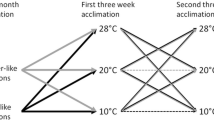Summary
Photoperiod is the primary environmental cue for seasonality in the Djungarian hamster (Phodopus sungorus). This species reduces its body weight by 30% during winter to reduce its energy requirements. The aim of this study was (1) to examine the influence of food intake on the body weight cycle and (2) to evaluate the role of photoperiod and melatonin in determining this seasonal cycle.
While body weight increased slightly (7%) from August through December in long photoperiod, it dropped significantly (32%) in the natural photoperiod group and food intake gradually decreased in this group by about 20%. After two periods of 40% food restriction, the hamsters in long photoperiod rapidly returned to their initial body weight. In contrast, hamsters under natural photoperiod only gained weight until they had reached the body weight of the controls at that particular time.
In a second experiment, hamsters were kept under natural photoperiod throughout the year. At 6 different intervals two groups of hamsters were implanted with melatonin capsules and transferred to either short (LD 8:16) or long photoperiod (LD 16:8). The results show that the seasonal change in body weight is caused by a combined action of photoperiod and a change in the animals' sensitivity towards photoperiod and melatonin.
Similar content being viewed by others
References
Figala J, Hoffmann K, Goldau G (1973) Zur Jahresperiodik beim Dsungarischen Zwerghamster Phodopus sungorus Pallas. Oecologia (Berlin) 12:89–118
Fuller WA, Stebbins LL, Dyke GR (1969) Overwintering of small mammals near Great Slave Lake, Northern Canada. Arctic 22:34–55
Gwinner E (1981) Annual rhythms: Circannual rhythms. In: Aschoff J (ed) Handbook of Behavioral Neurobiology, vol 5. Biological rhythms. Plenum Press New York, p
Heldmaier G, Steinlechner S (1981a) Seasonal control of energy requirements for thermoregulation in the Djungarian hamster (Phodopus sungorus), living in natural photoperiod. J Comp Physiol 142:429–437
Heldmaier G, Steinlechner S (1981b) Seasonal pattern and energetics of short daily torpor in the Djungarian hamster, Phodopus sungorus. Oecologia (Berlin) 48:265–270
Heldmaier G, Steinlechner S, Rafael J (1982) Nonshivering thermogenesis and cold resistance during seasonal acclimatization in the Djungarian hamster. J Comp Physiol 149:1–9
Hoffmann K (1973) The influence of photoperiod and melatonin on the testis size, body weight, and pelage colour in the Djungarian hamster (Phodopus sungorus). J Comp Physiol 85:267–282
Hoffmann K (1978) Effect of castration on photoperiodically induced weight gain in the Djungarian hamster. Naturwissenschaften 65:494
Hoffmann K (1979) Photoperiod, pineal, melatonin and reproduction in hamsters. In: Kappers JA, Pevet P (eds) The pineal gland of vertebrates including man, Progress in Brain Research, vol 52. Elsevier/North-Holland Biomedical Press, Amsterdam, pp 397–415
Hoffmann K (1981) The role of the pineal gland in the photoperiodic control of seasonal cycles in hamsters. In: Follett BK, Follett DE (eds) Biological clocks in seasonal reproductive cycles Wright, Bristol, pp 237–250
Hyvärinen H, Heikura K (1971) Effect of age and seasonal rhythm on the growth patterns of some small mammals in Finland and in Kirkenes, Norway. J Zool (Lond) 165:545–556
Iverson SL, Turner BN (1974) Winter weight dynamics in Microtus pennsylvanicus. Ecology 55:1030–1041
Melnyk RB, Boshes M (1980) Efficiency of food utilization during body weight gain in dormice (Glis glis). Physiol & Behavior 24:1017–1021
Mezhzherin VA (1964) Dehnel's phenomenon and its possible explanation. Acta Ther 8:95–114
Mrosovsky N (1978) Circannual cycles in hibernators. In: Wang LCH, Hudson JW (eds) Strategies in cold. Academic Press, New York San Francisco London, pp 21–65
Mrosovsky N, Fisher KC (1969) Sliding set points for body weight in ground squirrels during the hibernation season. Can J Zool 48:241–247
Reiter RJ (1972) Evidence for refractoriness of the pituitary-gonadal axis to the pineal gland in golden hamsters and its possible implications in annual reproductive rhythms. Anat Rec 173:365–372
Reiter RJ (1981) The mammalian pineal gland: Structure and function. Am J Anat 162:287–313
Rigaudiere N (1969) Les variations saisonnieres du metabolisme de base et de la thyroide chez les microtines. Arch Sci Physiol 23:215–241
Stebbins LL (1978) Some aspects of overwintering in Peromyscus. Can J Zool 56:386–390
Steinlechner S, Heldmaier G (1982) Role of photoperiod and melatonin in seasonal acclimatization of the Djungarian hamster, Phodopus sungorus. Int J Biometeor 26:329–337
Stetson MH, Matt KS, Watson-Whitmyre M (1976) Photoperiodism and reproduction in golden hamsters: Circadian organization and the termination of photorefractoryness. Biol Reprod 14:531–537
Stetson MH, Watson-Whitmyre M, Matt KS (1977) Termination of photorefractoryness in golden hamsters — photoperiodic requirements. J Exp Zool 202:81–87
Tast J (1972) Annual variations in the weights of wintering root voles, Microtus oeonomus, in relation to their food conditions. Ann Zool Fenn 9:116–119
Turek FW, Desjardins C, Menaker M (1975) Melatonin: antigonadal and progonadal effects in male golden hamsters. Science 190:280–282
Wunder BA, Dobkin DS, Gettinger RD (1977) Shifts of thermogenesis in the prairie vole (Microtus ochrogaster). Oecologia (Berlin) 29:11–26
Author information
Authors and Affiliations
Rights and permissions
About this article
Cite this article
Steinlechner, S., Heldmaier, G. & Becker, H. The seasonal cycle of body weight in the Djungarian hamster: photoperiodic control and the influence of starvation and melatonin. Oecologia 60, 401–405 (1983). https://doi.org/10.1007/BF00376859
Received:
Issue Date:
DOI: https://doi.org/10.1007/BF00376859




